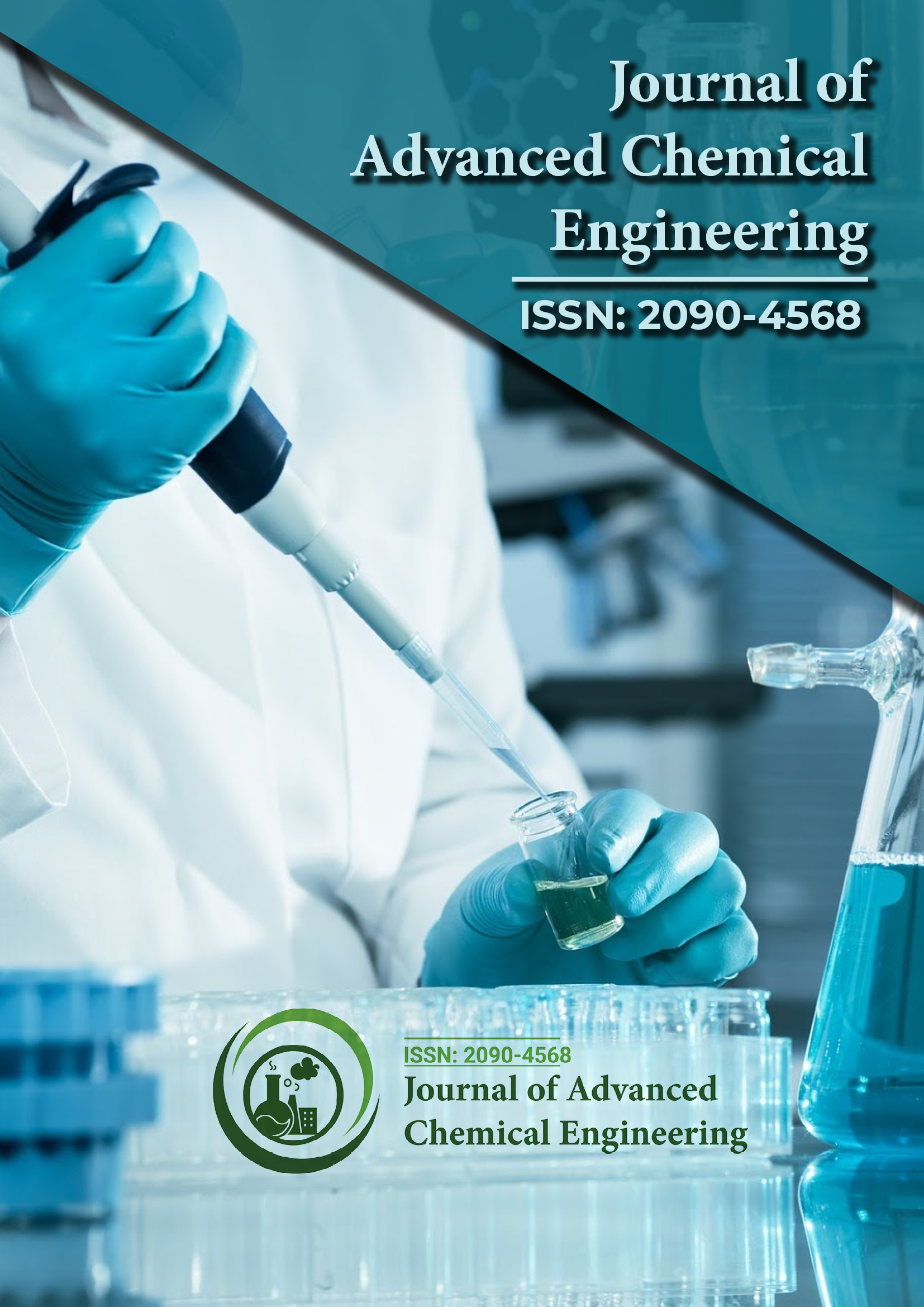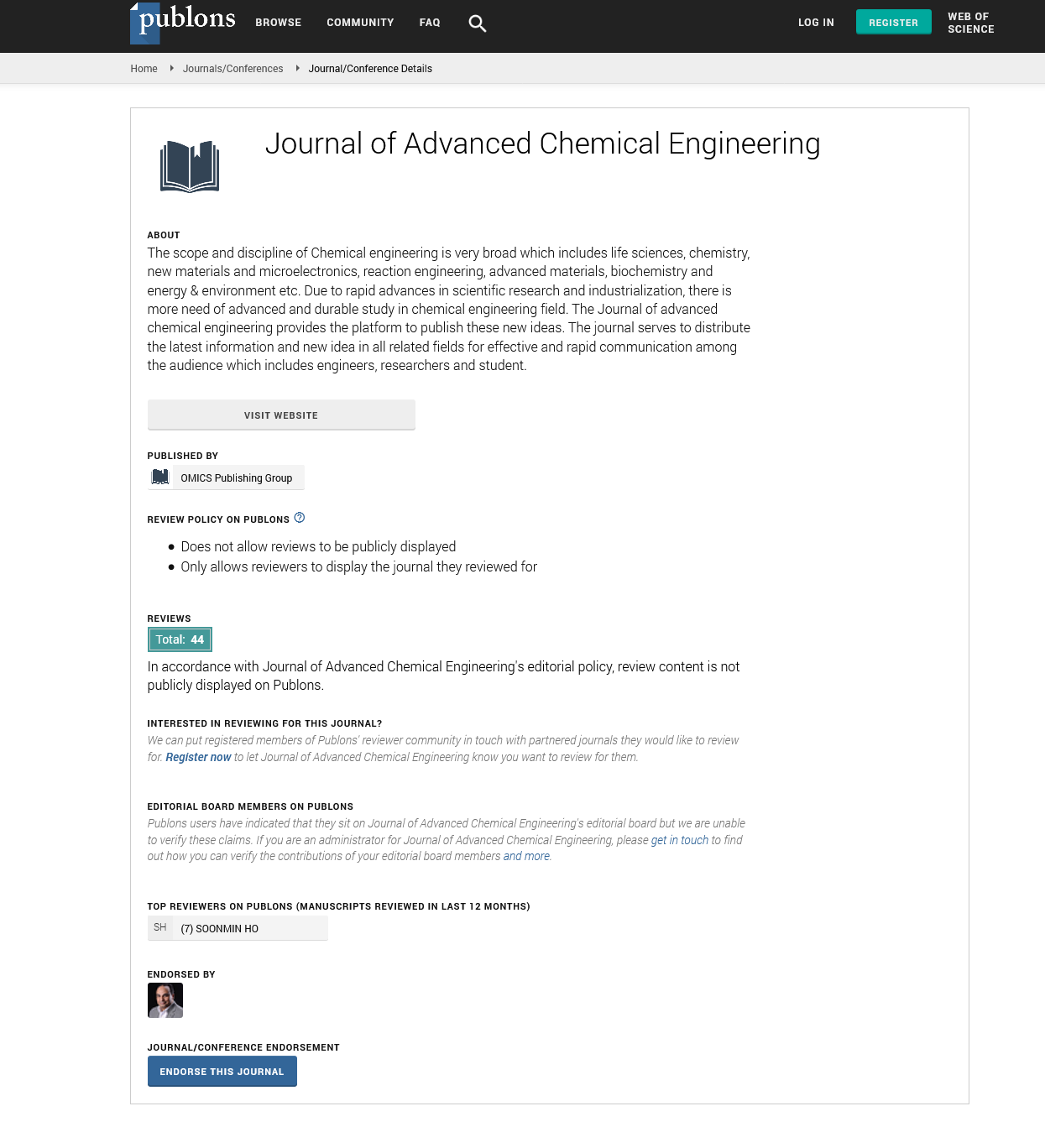Indexed In
- Open J Gate
- Genamics JournalSeek
- Smithers Rapra
- RefSeek
- Directory of Research Journal Indexing (DRJI)
- Hamdard University
- EBSCO A-Z
- OCLC- WorldCat
- Scholarsteer
- Publons
- Geneva Foundation for Medical Education and Research
- Google Scholar
Useful Links
Share This Page
Journal Flyer

Open Access Journals
- Agri and Aquaculture
- Biochemistry
- Bioinformatics & Systems Biology
- Business & Management
- Chemistry
- Clinical Sciences
- Engineering
- Food & Nutrition
- General Science
- Genetics & Molecular Biology
- Immunology & Microbiology
- Medical Sciences
- Neuroscience & Psychology
- Nursing & Health Care
- Pharmaceutical Sciences
Commentary - (2024) Volume 14, Issue 2
Improving Efficiency and Reducing Costs with Digital Solutions in Chemical Plants
Palm Stoy*Received: 20-May-2024, Manuscript No. ACE-24-26616 ; Editor assigned: 22-May-2024, Pre QC No. ACE-24-26616 (PQ); Reviewed: 05-Jun-2024, QC No. ACE-24-26616 ; Revised: 12-Jun-2024, Manuscript No. ACE-24-26616 (R); Published: 19-Jun-2024, DOI: 10.35248/2090-4568.24.14.332
Description
In recent years, the chemical process industry has been undergoing a significant transformation driven by advancements in digital technologies. This shift is reshaping how chemical plants operate, optimizing processes, improving safety, and enhancing productivity. The adoption of digital tools and strategies is not just a trend but a strategic necessity in a sector that faces increasing competition, regulatory pressures, and the need for greater efficiency.
The impact of digital technologies
Digital technologies are revolutionizing the chemical process industry in several key ways
Automation and control systems: Traditional chemical plants relied heavily on manual control systems and basic automation. Today, advanced digital control systems and automation technologies are widely implemented. These systems allow for real-time monitoring and control of chemical processes, enhancing precision and reducing human error. Automation helps streamline operations, ensuring that processes run smoothly and consistently.
Data analytics: The ability to collect and analyze vast amounts of data has transformed decision-making in the chemical process industry. Advanced data analytics tools enable companies to monitor process performance, predict potential issues, and optimize operations. For instance, predictive maintenance analytics can identify equipment that is likely to fail before it happens, reducing downtime and maintenance costs.
Internet of Things (IoT): IoT devices are increasingly used in chemical plants to gather data from various sensors and equipment. This real-time data collection facilitates better monitoring of process variables, such as temperature, pressure, and flow rates. IoT integration helps in maintaining optimal operating conditions and responding quickly to any deviations.
Artificial Intelligence (AI) and Machine Learning (ML): AI and ML technologies are being employed to enhance process optimization and decision-making. These technologies can analyze complex datasets to identify patterns and trends that might not be evident through traditional methods. For example, ML algorithms can optimize reaction conditions and improve yield by continuously learning from historical data and real-time process inputs.
Digital twins: A digital twin is a virtual replica of a physical process or system. In the chemical process industry, digital twins are used to simulate and analyze processes in a virtual environment before making changes in the real world. This approach allows for testing and refining process modifications without risking operational disruptions.
Benefits of digitalization
The digital transformation in the chemical process industry offers numerous benefits
Increased efficiency: Automation and advanced control systems reduce manual intervention and streamline operations. This leads to improved efficiency and consistency in production processes, which can result in cost savings and higher output.
Enhanced safety: Digital tools help in monitoring and managing safety parameters more effectively. Real-time data and predictive analytics can identify potential safety hazards and mitigate risks before they escalate. Additionally, digital systems can help in ensuring compliance with safety regulations and standards.
Cost reduction: By optimizing processes and reducing downtime, digital technologies contribute to lower operational costs. Predictive maintenance and real-time monitoring help in minimizing unexpected equipment failures and associated repair costs.
Better decision-making: Data-driven insights enable more informed decision-making. With access to real-time data and advanced analytics, plant operators and managers can make strategic decisions that enhance process performance and product quality.
Implementation challenges
Despite the clear advantages, the digitalization of the chemical process industry is not without its challenges
Integration with existing systems: Many chemical plants operate with legacy systems that may not be easily compatible with new digital technologies. Integrating advanced digital tools with older infrastructure can be complex and costly.
Data security: As chemical plants become more connected and data-driven, ensuring the security of sensitive information becomes critical. Cybersecurity measures need to be robust to protect against potential threats and breaches.
Skill gaps: The adoption of advanced digital technologies requires a workforce with the right skills and knowledge. There may be a need for training and upskilling to ensure that employees can effectively operate and maintain new systems.
Cost of implementation: The initial investment in digital technologies can be substantial. Companies need to carefully assess the return on investment and plan for long-term financial commitments.
The future of digitalization in the chemical process industry
Looking ahead, the digital transformation in the chemical process industry is expected to continue evolving
Further advancements in AI and ML: As AI and ML technologies become more sophisticated, their applications in the chemical process industry will expand. Enhanced algorithms and computational power will drive further innovations in process optimization and predictive analytics.
Increased use of Augmented Reality (AR) and Virtual Reality (VR): AR and VR technologies are likely to play a greater role in training, maintenance, and process design. These technologies can provide immersive and interactive experiences for operators and engineers.
Greater focus on sustainability: Digital tools will increasingly be used to support sustainability initiatives. Process optimization, waste reduction, and energy efficiency are areas where digital technologies can contribute to more environmentally friendly practices.
Collaboration and integration: The future will see more collaboration between digital technology providers and chemical companies. Integration of various digital solutions into a cohesive ecosystem will enhance overall process efficiency and performance.
Citation: Stoy P (2024) Improving Efficiency and Reducing Costs with Digital Solutions in Chemical Plants. Adv Chem Eng. 14.332.
Copyright: © 2024 Stoy P. This is an open-access article distributed under the terms of the Creative Commons Attribution License, which permits unrestricted use, distribution, and reproduction in any medium, provided the original author and source are credited.

